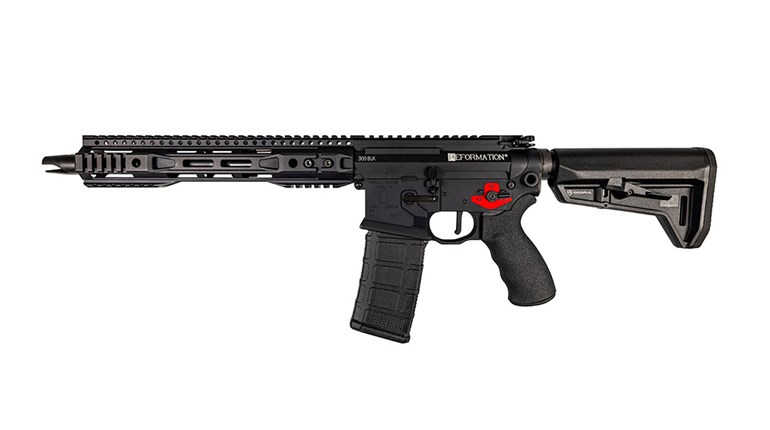
I thought the zenith of my AR trigger time was near the end of my Army days, while working in small arms R&D. I was wrong. Since retiring more than three years ago, I've upped my annual round count significantly. True to market trends, tactical rifles comprise my heaviest focus. I enjoy hand loading to squeeze the best performance out of my personal shooting, but I don't always have time to sit in front of a press, cranking out cartridges without distractions. Fortunately, my work also exposes me to lots of factory ammo—good, bad and sometimes downright ugly.
Not so many years ago, .223 Rem and 5.56 NATO loads were considered accurate enough for tactical use if they merely outshot the 2- to 3-inch groups typically seen with mil spec M855 "green tip" ammunition at 100 yards/meters. No longer. The best factory loads now force us to work harder to find the limits of practical accuracy. Personally, if I'm not on my A (+) game, good AR fodder will outshoot me quite handily.
Of the many brands and types of factory .223/5.56 ammunition I test, products from Black Hills and Hornady continually rise to the top. What follows are averaged results for my favorite factory loads. All group data is for 5-shot group averages for several rifles, from prone, bipod-assisted positions at 100 yards with various magnified optics.
Black Hills 77-grain match, 5.56 NATO
Black Hills products are well known for their quality in military, law enforcement and competitive shooting circles. Its new-for-2011 commercial 77-grain Sierra MatchKing (SMK) match load is identical to USSOCOM's MK262 Mod 1 ammunition. The large amount of MK262 I've shot over the years—in uniform and out—has always been a solid performer. The commercial version is essentially the same load and is proving very accurate in my current work.
Accuracy range: .4 to 1 inch, 1:7- and 1:8-inch twist, 2,750 fps (18-inch barrel)
Until Black Hills released the 77-grain load described above, this was my hands-down favorite for wringing out a 1:7- or 1:8-inch twist barrel. I reserve it for rifles that first demonstrate superb accuracy with another factory load. Sub-MOA accuracy is a sure bet in a good barrel and .5 to .75 MOA is common.
Accuracy range: .5 to .9 inch, 1:7- and 1:8-inch twist, 2,770 fps (16-inch barrel)
Hornady's Superformance line continues to grow, and for good reason. The clever minds in Grand Island, NE, have concocted some excellent loads that push well beyond standard velocities. Its 75-grain Superformance loads—available in both 5.56 NATO and .223 Rem.—have performed very well for me.
Accuracy range: .6 to 1 inch, 1:7- and 1:8-inch twist, .223 Rem.: 2,655 fps, 5.56 NATO: 2,915 fps (18-inch barrel, 5.56 NATO chamber)
The "For Personal Defense" tag clearly indicates the purpose of this ammunition line. Adapted from military and law enforcement offerings, TAP-PFD is designed specifically for close-range encounters with dangerous targets. Nickel-plated cases help ensure smooth cycling in semi-autos. I've had the best success with 60-grain loads.
Accuracy range: .6 to 1.1 inches, 1:7-, 1:8- and 1:9-inch twist, 2,850 fps (18-inch barrel)
Hornady produces a whole fleet of excellent varmint projectiles. Not only does this thinly jacketed 55-grain load flatten wily four-legged critters, it's accuracy is nothing short of phenomenal in 1:8- and 1:9-inch twist barrels. To be perfectly honest, these factory loads give my best hand loads (using the same projectile) a run for the money. Sub-.5 MOA grouping is not uncommon in my testing, and I've heard similar feedback from fellow accuracy buffs.
Accuracy range: .4 to .7 inch, 1:8- and 1:9-inch twist, 2,705 fps (16-inch barrel)
It's easy to get confused by the differences between .223 Rem. and 5.56 NATO (aka 5.56x45 mm). In the simplest terms, either cartridge can be safely used in a firearm with a 5.56 NATO chamber, but the reverse is not true. Differences in chamber/throat dimensions and design can create excessive pressure—the kind that damages things—if 5.56 NATO ammo is fired in a .223 Rem. chamber. While factory ammunition is normally marked appropriately, the same cannot be said of firearms and barrels. I've come across several barrels that are marked one way, but cut the other. Be sure your firearm is capable of handling 5.56 NATO before shooting any. Refer to both the markings on the gun and the owner's manual. Contact the manufacturer for guidance if in doubt.
NATO-spec chambered 5.56 barrels usually show a slight accuracy preference and higher velocities when shooting 5.56 NATO ammo. However I see very good accuracy with both ammunition types in most cases. Another option is to use a .223 Wylde chamber, which is safely rated for either cartridge, but has a slight velocity edge over 5.56 NATO chambers when shooting .223 Rem ammo. The results indicated above were achieved using both .223 and 5.56 ammunition in 5.56 NATO chambers.




































